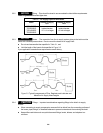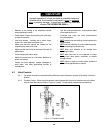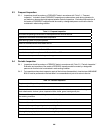
20
The operation of an overhead hoist involves more than activating the hoist’s controls. Per the ANSI/ASME B30
standards, the use of an overhead hoist is subject to certain hazards that cannot be mitigated by engineered features,
but only by the exercise of intelligence, care, common sense, and experience in anticipating the effects and results of
activating the hoist’s controls. Use this guidance in conjunction with other warnings, cautions, and notices in this manual
to govern the operation and use of your overhead hoist.
4.2 Shall’s and Shall Not’s for Operation
WARNING
Improper operation of a hoist can create a potentially hazardous
situation which, if not avoided, could result in death
or serious injury,
and substantial property damage. To avoid such a potentially
hazardous situation THE OPERATOR SHALL:
• NOT
lift more than rated load for the hoist.
• NOT
operate unless load is centered under hoist.
• NOT
use damaged hoist or hoist that is not working
properly.
• NOT
use hoist with twisted, kinked, damaged, or
worn chain.
• NOT
use hoist if the bottom hook is capsized
(double fall hoists - see Section 3.11).
• NOT
use the hoist to lift, support, or transport
people.
• NOT
lift loads over people.
• NOT
apply load unless load chain is properly
seated in the load sheave (and idle sheave for hoist
with two chain falls).
• NOT
use the hoist in such a way that could result in
shock or impact loads being applied to the hoist.
• NOT
attempt to lengthen the load chain or repair
damaged load chain.
• NOT
operate hoist when it is restricted from forming
a straight line from hook to hook in the direction of
loading.
• NOT
use load chain as a sling or wrap load chain
around load.
• NOT
apply the load to the tip of the hook or to the
hook latch.
• NOT
apply load if binding prevents equal loading
on all load supporting chains.
• NOT
operate beyond the limits of the load chain
travel.
• NOT
operate hoist with missing/damaged chain
springs, shock absorbers, stoppers, striker plates or
limit locks.
• NOT
leave load supported by the hoist unattended
unless specific precautions have been taken.
• NOT
allow the chain, or hook to be used as an
electrical or welding ground.
• NOT
allow the chain, or hook to be touched by a
live welding electrode.
• NOT
remove or obscure the warnings on the hoist.
• Be familiar with operating controls, procedures, and
warnings.
• Make sure the unit is securely attached to a
suitable support before applying load.
• Make sure load slings or other approved single
attachments are properly sized, rigged, and seated
in the hook saddle.
• Take up slack carefully - make sure load is
balanced and load-holding action is secure before
continuing.
• Make sure all persons stay clear of the supported
load.
• Protect the hoist’s load chain from weld splatter or
other damaging contaminants.
• Report malfunctions or unusual performances
(including unusual noises) of the hoist and remove
the hoist from service until the malfunction or
unusual performance is resolved.
• Make sure hoist limit switches function properly.
• Warn personnel before lifting or moving a load.
• Warn personnel of an approaching load.


















